Deaths
which occurred on a July 31:
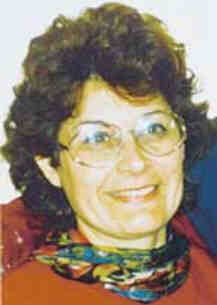 2002
Two Israelis and 5 US nationals, by a bomb exploding
at lunchtime in the cafeteria in the International Frank Sinatra Student
Center building of Hebrew University's Mount Scopus campus in Jerusalem.
The ceiling collapses. 86 persons are injured, of which two Israeli
women would die later of their injuries: Daphna Spruch, 61, from Jerusalem,
on 10 August; and Revital Barashi, 30, on 13 August. Hamas announces
that it has placed the bomb (not a suicide bombing). 2002
Two Israelis and 5 US nationals, by a bomb exploding
at lunchtime in the cafeteria in the International Frank Sinatra Student
Center building of Hebrew University's Mount Scopus campus in Jerusalem.
The ceiling collapses. 86 persons are injured, of which two Israeli
women would die later of their injuries: Daphna Spruch, 61, from Jerusalem,
on 10 August; and Revital Barashi, 30, on 13 August. Hamas announces
that it has placed the bomb (not a suicide bombing).
According to Reuters the al-Aqsa body count now stands at “at
least 1472 Palestinians and 573 Israelis” [others count more].
 The dead Israelis are:
The dead Israelis are:
Levina
Shapira, 53 [photo >], was from a long-established
Jerusalem family. She was head of the Student Authority at Hebrew
University, where she had worked for 33 years.
Diego
“David” Ladovsky, 29 [<photo], had
just entered the Israeli diplomatic service and was supposed to go
in 10 days to Lima, Peru, as second secretary in the embassy. Ladovsky
had just completed a master's degree in public administration; he
was at the university this day to turn in his final project. Ladovsky
was born in Argentina and moved to Israel in 1992. He completed his
bachelor's degree and then his army service, and then worked for a
while in the Communications Ministry. In 2000, he joined the Foreign
Ministry's diplomatic training program.
The dead US nationals are:
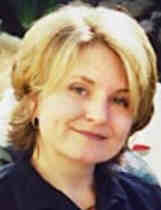 Janis
Ruth Coulter [< photo], born on 05 August
1966, was an assistant director of graduate studies for the Hebrew
University's Rothberg International School in New York. She was escorting
a group of 20 US students to Israel. Coulter grew up in Boston's West
Roxbury neighborhood and was raised as an Episcopalian, but converted
to Judaism in 1996. After graduating from the University of Massachusetts
at Amherst in 1991, she went on to Denver's Institute for Islamic-Judaic
Studies, where she was about to finish her master's thesis on the
Book of Ruth. In 1999 she moved to New York to take a job with Hebrew
University's admissions department. She also had spent an entire year
at Hebrew University, pursuing her master's degree and learning Hebrew.
Her body was identified by her jewelry and her dental records Janis
Ruth Coulter [< photo], born on 05 August
1966, was an assistant director of graduate studies for the Hebrew
University's Rothberg International School in New York. She was escorting
a group of 20 US students to Israel. Coulter grew up in Boston's West
Roxbury neighborhood and was raised as an Episcopalian, but converted
to Judaism in 1996. After graduating from the University of Massachusetts
at Amherst in 1991, she went on to Denver's Institute for Islamic-Judaic
Studies, where she was about to finish her master's thesis on the
Book of Ruth. In 1999 she moved to New York to take a job with Hebrew
University's admissions department. She also had spent an entire year
at Hebrew University, pursuing her master's degree and learning Hebrew.
Her body was identified by her jewelry and her dental records
David Gritz, 24, dual
US-French citizen, was the son of a Croatian mother and a US father.
David Gritz grew up in Paris, where his father was a teacher, but
spent his summers at his parents' house in the small town of Peru
in the Berkshires, about 15 km east of Pittsfield. Gritz had studied
at McGill University in Montreal for one year before he attended Sorbonne
University in Paris, where he earned a degree in philosophy. He was
to begin a graduate course in Jewish thought at Hebrew University
the next day.
Benjamin
Blutstein, 25, of Susquehanna Township, Pennsylvania, was
on a two-year graduate study program to be a teacher of Jewish studies.
He was expected to return to Pennsylvania the next day.
Marla
Bennett, 24, of San Diego, had been doing joint graduate
work at Pardes Institute and Hebrew University in Judaic Studies.
She was due to return home two days later to spend about a month visiting
family before returning to Israel. She was in the second year of a
three-year master's program in Judaic Studies, and had been at the
university to take a final exam in her sole Hebrew University class
of the semester, Hebrew Language. She graduated from the University
of California at Berkeley with a bachelor's in political science and
had spent her junior year of undergraduate study in Israel.
Dina Carter, 37, with
dual nationality US-Israel, born in North Carolina, studied anthropology
at Duke University, and social work at Chappel High University. Moved
to Israel in 1990 and worked as a librarian and archivist in the National
Library on Mount Scopus. |
2002 Rachel Rahmé Saadé, directrice de la Caisse des indemnités
du corps enseignant dans les écoles privées du Liban, Moussa Chouéri,
directeur de département à la caisse, Carlos Salamé, Maria Tabet,
Maroun Moussa, Huguette Féghali (secrétaire générale de la section
Mont-Liban au syndicat des enseignants), Sleimane Jamous,
et Sakiné Harkous, massacrés à coups de feu
par Ahmed Mansour, 46 ans, planton à la Caisse depuis 25 ans, à
son arrivée à 10 heures avec 2 heures de retard, muni dans
un cartable de deux mitraillettes, un revolver, et une grenade, au siège
de la Caisse, à la rue Mama, près de la corniche de Mazraa, au troisième
étage de l’immeuble Omaiss, à Beyrout. Cinq autres personnes sont
blessées. Mansour est musulman, la plupart de ses victimes sont chrétiennes.
Voici une semaine que la directrice lui réclamait le remboursement
de l'emprunt de 18 millions de livres libanaises (US$12'000) qu'il doit
à la Caisse mais qu'il ne trouve pas moyen de payer.
2001 Ashraf Khader, 5, Bilal
Khader, 8, Jamal Mansour, 42, Jamal Salim, 41, Fahim Dawabshe, 32,
and four other Palestinians, killed by Israel.
Israeli helicopters fire missiles into
offices of Hamas in Nablus, West Bank. Brothers Ashraf and Bilal Khader,
in town for a visit, are killed by shrapnel, as they stand on the
street with their mother, Nadia Khader, who is unhurt. The main target
is Mansour, a senior Hamas leader in the West Bank who has been arrested
repeatedly by the Israelis and the Palestinian Authority. Israel said
Mansour was part of the Hamas leadership responsible for attacks that
included the 1 June suicide bombing of a Tel Aviv disco that killed
21 Israelis. Salim and Dawabshe were regional Hamas leaders. Three
more Palestinians inside the Hamas offices are killed in this attack.
Two Palestinians are also killed this
same day, in the Gaza Strip — one shot by Israeli troops, the
other appeared to fall victim to an internal Palestinian feud.
In Beit Sahour, West Bank, a 57-year-old
man believed to be a collaborator with Israel is shot and killed by
Palestinians.
A Palestinian security
court in Nablus sentences three Palestinians to death for helping
Israel kill Fatah activist Thabet Thabet in December 2000. Another
man is sentenced to 15 years in prison and a fifth is released. Arafat
has to approve the death sentences before they can be carried out.
The previous day, six Palestinian activists
were killed when a roadside car parts store exploded outside Nablus,
not far from Tuesday's attack. All six belonged to the Fatah movement
headed by Arafat.
The al-Aqsa
intifada (started 28 September 2000) body count thus stands at 548
Palestinians and 133 Israelis. |
1995 El INI (Instituto Nacional de Industria) de España,
casi 54 años después de su creación.
1995 Mrs.
Irene Aitken, 65, in Hyde, England, by lethal dose of opiates
administered by Dr. Harold Shipman (murderer
of 215+) during a home visit.
1993 Balduino I,
rey de Bélgica.
1987 Más de 400 personas, en choques
entre iraníes y fuerzas de la policía saudí, en los alrededores de la Gran
Mezquita de la La Meca, adonde habían acudido en peregrinación.
1982
44 niños y nueve adultos, abrasados en un accidente de autobús
en el sur de Francia.
1981 General Omar Torrijos,
52, in plane crash. He was dictator of Panama by virtue of the Guardia Nacional
whose October 1968 coup put him in power, and of which he was still commander
at his death.
1977
Last victims of Son of Sam ^top^
On 29 July 1976 the so-called "Son
of Sam" pulled a gun from a paper bag and fires five shots at Donna
Lauria and Jody Valenti of the Bronx while they are were sitting in
a car, talking. Lauria died and Valenti was seriously wounded in the
first in a series of shootings by the serial killer, who terrorized
New York City over the course of the next year. Once dubbed the ".44
Caliber Killer," the Son of Sam eventually got his name from letters
he sent to both the police and famed newspaper writer Jimmy Breslin
that said, "I am a monster. I am the Son of Sam. I love to hunt, prowling
the streets looking for fair game. The weman are prettyist of all
[sic]."
The second attack came
on October 23, 1976, when a couple was shot as they sat in a car in
Queens. A month later, two girls were talking on a stoop outside a
home when the serial killer approached, asked for directions, and
then suddenly pulled a gun out and fired several shots. Joanne Lomino
was paralyzed from a bullet that struck her spine, but her friend
was not seriously injured. The Son of Sam attacked again in January
and March of 1977. In the latter attack, witnesses provided a description
of the killer: an unattractive White man with black hair.
After yet another shooting in the Bronx in April, the publicity hit
a fever pitch. Women, particularly those with dark hair, were discouraged
from traveling at night in the city. When the Son of Sam missed his
intended victims in another murder attempt in June, vigilante groups
formed across New York City looking for the killer.
His last victims were murdered on July 31, 1977, in Brooklyn.
Following up on a parking ticket that
had been given out that night, police discovered a machine gun in
a car belonging to David Berkowitz of Yonkers, New York. When questioned,
Berkowitz explained that "Sam" was his neighbor Sam Carr—an agent
of the devil. Sam transmitted his orders through his pet black Labrador.
Years earlier, Berkowitz had shot the dog, complaining that its barking
was keeping him from sleeping. After the dog recovered, Berkowitz
claimed that it began speaking to him and demanding that he kill people.
In an unusual sequence of events, Berkowitz was allowed to plead guilty
before claiming insanity and was sentenced to over 300 years in prison.
In prison, he later claimed to be a born-again Christian. |
|
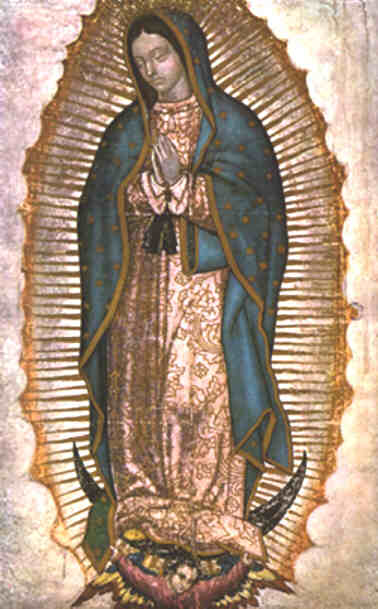 On
a July 31:
On
a July 31: 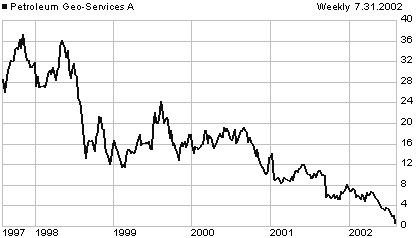 2002
Petroleum Geo Services (PGO) is downgraded by Merrill Lynch from Long Term
Strong Buy to Long Term Neutral. On the New York Stock exchange its stock
drops from the previous close of $2.14 to an intraday low of $0.47 and a
close of $0.56. PGO had traded as high as $10.84 on 22 August 2001 and $38.41
on 03 November 1997. [< 5~year price chart]
2002
Petroleum Geo Services (PGO) is downgraded by Merrill Lynch from Long Term
Strong Buy to Long Term Neutral. On the New York Stock exchange its stock
drops from the previous close of $2.14 to an intraday low of $0.47 and a
close of $0.56. PGO had traded as high as $10.84 on 22 August 2001 and $38.41
on 03 November 1997. [< 5~year price chart]

 2002
2002 The dead Israelis are:
The dead Israelis are: Janis
Ruth Coulter [< photo], born on 05 August
1966, was an assistant director of graduate studies for the Hebrew
University's Rothberg International School in New York. She was escorting
a group of 20 US students to Israel. Coulter grew up in Boston's West
Roxbury neighborhood and was raised as an Episcopalian, but converted
to Judaism in 1996. After graduating from the University of Massachusetts
at Amherst in 1991, she went on to Denver's Institute for Islamic-Judaic
Studies, where she was about to finish her master's thesis on the
Book of Ruth. In 1999 she moved to New York to take a job with Hebrew
University's admissions department. She also had spent an entire year
at Hebrew University, pursuing her master's degree and learning Hebrew.
Her body was identified by her jewelry and her dental records
Janis
Ruth Coulter [< photo], born on 05 August
1966, was an assistant director of graduate studies for the Hebrew
University's Rothberg International School in New York. She was escorting
a group of 20 US students to Israel. Coulter grew up in Boston's West
Roxbury neighborhood and was raised as an Episcopalian, but converted
to Judaism in 1996. After graduating from the University of Massachusetts
at Amherst in 1991, she went on to Denver's Institute for Islamic-Judaic
Studies, where she was about to finish her master's thesis on the
Book of Ruth. In 1999 she moved to New York to take a job with Hebrew
University's admissions department. She also had spent an entire year
at Hebrew University, pursuing her master's degree and learning Hebrew.
Her body was identified by her jewelry and her dental records 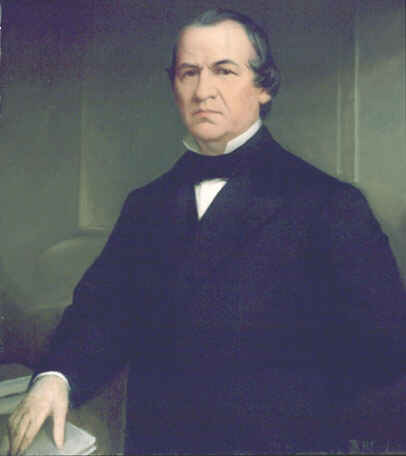 1929
Ángel Lizcano y Monedero, pintor español.
1929
Ángel Lizcano y Monedero, pintor español.
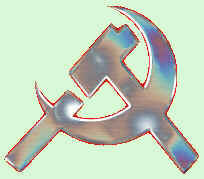 1837
William Clarke Quantraill, Confederate raider known as one of the
most vicious butchers of the American Civil war.
1837
William Clarke Quantraill, Confederate raider known as one of the
most vicious butchers of the American Civil war.